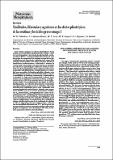Por favor, use este identificador para citar o enlazar a este item:
http://hdl.handle.net/10261/63028COMPARTIR / EXPORTAR:
 SHARE SHARE
 CORE
BASE CORE
BASE
|
|
| Visualizar otros formatos: MARC | Dublin Core | RDF | ORE | MODS | METS | DIDL | DATACITE | |

| Título: | Similarities, differences and agonisms of pleiotropic effects of statins and omega-3 fatty acids | Similitudes, diferencias y agonismos en los efectos pleiotrópicos de las estatinas y los ácidos grasos omega-3 |
Autor: | Villalobos, M. E.; Sánchez-Muniz, F. J.; Acín, M. T.; Vaquero, M. Pilar CSIC ORCID ; Higueras, F. J.; Bastida, Sara | Fecha de publicación: | 2010 | Editor: | Aula Médica Ediciones | Citación: | Nutricion Hospitalaria 25: 889- 909 (2010) | Resumen: | This paper compares the pleiotropic effects of statins and omega-3 fatty acids (n-3 PUFA) in treating and preventing cardiovascular disease (CVD) and deals with the possible interactions of those compounds. Statins represent one of the most important discoveries to have been made in the field of cardiovascular medicine in recent decades. Their beneficial cardiovascular effects, which have reduced the number of fatal events in patients with atherosclerosis, encompass more than their ability to lower cholesterol levels. The pleiotropic effects of statins involve their anti-inflammatory and antiplatelet properties and their ability to normalize endothelial function. In addition, these drugs may display antiarrhythmic activity, improve insulin sensitivity and counteract hypertension and obesity. The low rate of coronary disease documented in Eskimos corroborates the cardioprotective effects of the n-3 PUFA eicosapentaenoic (EPA) and docosahexaenoic acids beyond their hypolipemic effects. The reduction of CVD-related deaths attributable to the action of α-linolenic fatty acid appears to be related to its strong antiarrhythmic properties. In addition, as a precursor of EPA and this last fatty acid of thromboxane A3, prostacyclin I3, serie-3 prostaglandines and serie 5- leukotrines and inhibitor/modulator of thromboxane A2, prostacyclin I2, serie-2 prostaglandines and serie 4- leukotrienes formation, the α-linolenic acid may reduce inflammation and thrombogenesis. As results of some studies suggest that the combined use of statins and n-3 PUFA improves cardiovascular protection and reduces the CVD-related mortality rate; the paper also reviews the possible synergism between both groups of compounds on CVD treatment and concludes that clear benefits may be obtained. | URI: | http://hdl.handle.net/10261/63028 | DOI: | 10.3305/nh.2010.25.6.4819 | Identificadores: | doi: 10.3305/nh.2010.25.6.4819 issn: 0212-1611 e-issn: 1699-5198 |
| Aparece en las colecciones: | (ICTAN) Artículos |
Ficheros en este ítem:
| Fichero | Descripción | Tamaño | Formato | |
|---|---|---|---|---|
| Similitudes, diferencias y agonismos en los efectos pleiotrópicos.pdf | 188,07 kB | Adobe PDF |  Visualizar/Abrir |
CORE Recommender
SCOPUSTM
Citations
8
checked on 03-may-2024
WEB OF SCIENCETM
Citations
8
checked on 20-feb-2024
Page view(s)
329
checked on 03-may-2024
Download(s)
591
checked on 03-may-2024
Google ScholarTM
Check
Altmetric
Altmetric
NOTA: Los ítems de Digital.CSIC están protegidos por copyright, con todos los derechos reservados, a menos que se indique lo contrario.
